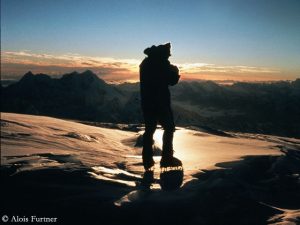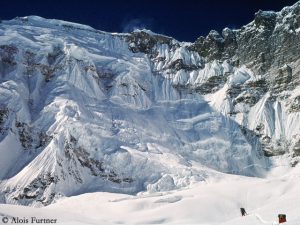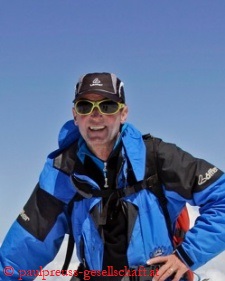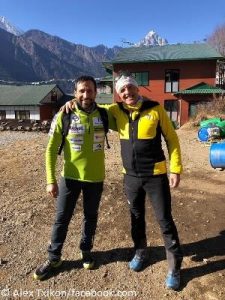40 years ago: Secret matter Cho Oyu Southeast Face
Only the spouses were in the know. The three Austrians Edi Koblmüller, Alois Furtner and Gerhard Haberl as well as the two Germans Herbert Spousta and Peter von Gizycki had agreed on strict secrecy. After all, the eight-thousander Cho Oyu was not open to climbers in Nepal in 1978. So the five climbers disguised themselves as trekking tourists and hiked to Gokyo. Their actual destination was a few kilometers behind: the 3,000-meter-high Southeast Face of the 8,188-meter-high Cho Oyu. “I was obsessed with this idea,” Alois Furtner, who reached the summit with Koblmüller on 27 October 1978, writes to me. The others turned around about 200 meters below the summit. “Friends of ours later called it a ‘century adventure’. Today I know that it was a very courageous undertaking,” recalls the now 70-year-old Furtner. “At that time I was so determined and focused that it had to happen. Just as a pregnant woman has to give birth to her child, I had to realize this plan in a similar way. And I succeeded.”
Sleeping in snow caves
A picture of the upper part of the wall in a book by Reinhold Messner had inspired the quintet. The mountaineers had no more information. First, they carried about 250 kilograms of equipment from Gokyo to the base camp at 5,100 meters. Koblmüller, Furtner and von Gizycki ascended to an altitude of 6,700 meters at the foot of the summit wall. There they deposited a tent with equipment and descended again. On 22 October the five mountaineers started their summit attempt. They climbed in “pure Alpine style”, Furtner says. “We had no Sherpas on the mountain, no supplies, no bottled oxygen, no communication with the outside world, we were completely on our own. There was also no doctor. We were not allowed to make any mistakes,” says Alois. “Food, petrol, fixed ropes were reduced to a minimum. We only used tents in the lower part of the wall. In the summit wall we dug out snow caves to reduce weight.”
Like Brocken spectres
The summit wall demanded everything from climbers. Their route led over an ice pillar in the middle of the wall, which was up to 70 degrees steep. In the morning of the summit day the thermometer showed minus 40 degrees Celsius. Haberl got frostbite at his fingertips, which finally cost him the summit. Furtner and Koblmüller reached the highest point shortly before sunset. “We both knew that we had achieved something great,” recalls Alois. “I had four turquoise stones around my neck. I pressed one of them into the snow of the ‘Turquoise Goddess’ (that’s the translation of Cho Oyu) at the summit in return for good luck. I remember one thing – it was mythical: The setting sun enlarged our shadows and threw them onto the wall of fog in the direction of Everest, it was like Brocken spectres.”
Five years entry ban
The descent turned into a race against time. At 6,600 meters the five mountaineers were snowed in. Two nights and a complete day they crowded together in a tent, food was running out. The quintet digged their way down to the valley through partly breast-high snow and finally reached the base camp on 1 November, ten days after setting off for their summit push. One day later they were back in Gokyo. Because they had climbed Cho Oyu without a permit, the Nepalese authorities punished the climbers with a five-year travel ban. “At that time our ascent virtually disappeared,” reports Furtner. “In the same year, Messner and Habeler climbed Everest without bottled oxygen – that was the world sensation.”
“The adventure of my life”
To date, the route via the Southeast Face of Cho Oyu, completed by Furtner and Koblmüller (who froze to death in a snowstorm in Georgia in 2015), has not been repeated. That actually says it all about its degree of difficulty. “Looking back, I’m still deeply moved by how we climbed the wall back then. There were so many obstacles on the way to the summit and also on our way back. And yet we all arrived at the base camp relatively unharmed,” says Alois Furtner. “It was the adventure of my life, and the summit picture was the photo of my life.”
The Cho Oyu pioneer takes a critical view of today’s Himalayan mountaineering. “Gokyo becomes a Zermatt in the Himalayas, the peaks are climbed in hundreds and the ascents are broadcasted live. I lean back calmly and think of our happy ascent with a feeling of well-being,” says Alois. “I am also very pleased that Reinhold Messner, in his Cho Oyu book, classifies our ascent as a ‘milestone in climbing great Himalayan walls’. I accept this compliment gratefully.”
P.S.: Yes, yes, I know, the anniversary was two months ago – but 40 years ago is still true. 😉











